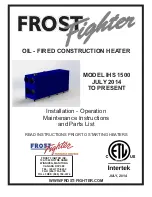
9
Cleaning and maintenance
Logalux LTN/LTD/LTH/LF 400...3000 – 6 720 818 806 (2015/12)
22
9
Cleaning and maintenance
We recommend that the DHW cylinder is checked and cleaned by a
qualified contractor at the regular intervals shown in tab. 8, page 22.
▶ The system user should be informed of this.
▶ Shorter cleaning intervals should be chosen, if there are
unfavourable water operating conditions (hard or very hard water) in
conjunction with high temperature loads.
9.1
Preparing the DHW cylinder for
cleaning
▶ Disconnect the heating system from the power supply.
▶ Drain the DHW cylinder. To do so, close the shut-off valve for cold
water inlet (EK) and open the drain valve (EL). In order to vent the
cylinder, open the air vent valve or the highest draw-off tap.
9.2
Cleaning the DHW cylinder
▶ Before unscrewing the manhole cover, unscrew the external current
anode and remove the earth conductor. In doing so, take care not to
damage the external current anode!
▶ Do not drop the manhole cover into the cylinder.
▶ Inspect the inside of the DHW cylinder for limescale.
▶ Break up large scale deposits with a wooden rod before flushing the
cylinder.
▶ If necessary, flush out the inside of the DHW cylinder with a “hard
”cold water jet (4...5 bar pressure).
Removing hard crusts
If extremely encrusted limescale has built up inside the DHW cylinder,
this can be removed by chemical cleaning with a suitable scale remover
(e.g. with Citro Plus from Sanit). For this, it has proven beneficial to
disconnect the DHW cylinder from the network on its potable water side
to prevent any contamination of the potable water.
9.3
External current anode
The protective function of the external current anode is shown by a green
indicator light in the control unit.
In the event of a fault, the indicator light flashes red.
At the same time, the cylinder primary pump is shut down.
▶ If the indicator light flashes red, contact your contractor.
9.4
Maintenance intervals
Cold water contains water and parts of dissolved substances, primarily
limestone. The latter determines the so-called "water hardness". When
water is heated, limestone is precipitated, i.e. it is deposited in the
device and collects on the smooth-tube heat exchanger or immersion
heaters, or it settles on the cylinder floor. The quantity of limestone and
therefore of limescale depends on the amount of limestone dissolved in
the water, on the water temperature and on the water throughput. As a
general principle,
the higher the values listed below, the more limestone is precipitated
from the water and is deposited, and the shorter the maintenance and
cleaning intervals of the device being operated.
The table below gives
reference values
for the maintenance intervals;
however, due to the wide variety of water hardness levels and operating
conditions, these only represent rough recommended values and are
therefore non-binding. Claims based on these reference values do not
have any foundation. Depending on the composition of the water in
individual regions, it can make sense to deviate from the reference
Maintenance must be carried out regularly, and at the latest:
NOTICE:
Risk of cylinder damage through poor cleaning
and maintenance!
▶ Carry out cleaning and maintenance at least every
2 years.
▶ Remedy all faults immediately.
Regular maintenance of the solids filter in the water supply
is required for hygiene reasons. We recommend arranging a
maintenance and inspection contract with the system user.
DANGER:
Risk of scalding from hot water!
▶ Let the DHW cylinder cool down sufficiently after
shutting it down.
NOTICE:
Risk of cylinder damage through a damaged
surface finish!
▶ Never use hard metal objects or tools with sharp
edges to clean the inside of the DHW cylinder.
You can increase the cleaning effect of the jet by heating up
the drained DHW cylinder before flushing. The thermo-
shock effect loosens limescale more easily from the smooth-
tube heat exchanger.
If scale deposits are severe and affect a larger number of
cylinders, we recommend using an industrial vacuum
cleaner
NOTICE:
Risk of irreparable damage from incorrect
handling!
▶ Avoid any contamination of the external current anode
by oil or grease!
Water hardness as
calcium carbonate
mol/m
3
Water hardness
1
2
3
4
5
6
°dH
Standard flow rate,
domestic hot water
temperature
60 °C
Higher flow rate,
domestic hot water
temperature
60 °C
Standard flow rate,
domestic hot water
temperature
70 °C
Higher flow rate,
domestic hot water
temperature
70 °C
Standard flow rate,
domestic hot water
temperature
> 60 °C
Higher flow rate,
domestic hot water
temperature
> 70 °C
< 1.5
< 8.4
< 24 months
< 21 months
< 21 months
< 18 months
< 15 months
< 12 months
1.5...2.5
8.4...14
< 21 months
< 18 months
< 18 months
< 15 months
< 12 months
< 9 months
> 2.5
> 14
< 15 months
< 12 months
< 12 months
< 9 months
< 6 months
< 6 months
Table 9 Maintenance intervals
Summary of Contents for Logalux LTD950
Page 24: ......



































